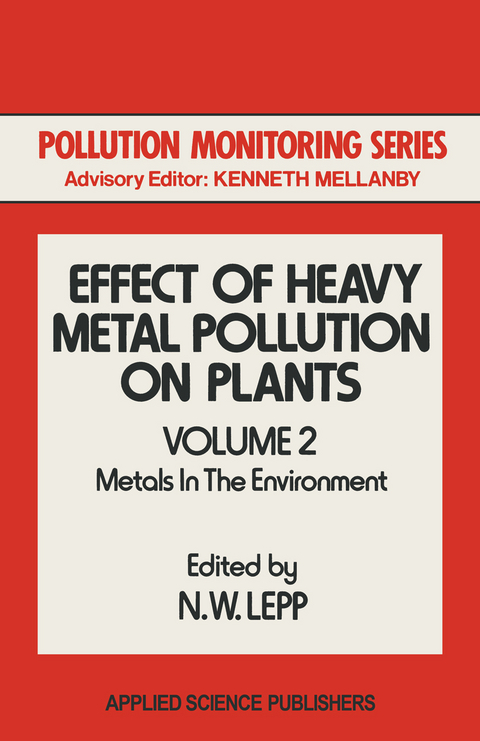
Effect of Heavy Metal Pollution on Plants
Metals in the Environment
Seiten
2012
Springer (Verlag)
978-94-009-8101-0 (ISBN)
Springer (Verlag)
978-94-009-8101-0 (ISBN)
Trace metals occur as natural constituents of the earth's crust, and are ever present constituents of soils, natural waters and living matter. When the interactions between trace metals and plants are considered, one must take full account of the known chemical properties of each element.
Trace metals occur as natural constituents of the earth's crust, and are ever present constituents of soils, natural waters and living matter. The biological significance of this disparate assemblage of elements has gradually been uncovered during the twentieth century; the resultant picture is one of ever-increasing complexity. Several of these elements have been demonstrated to be essential to the functions of living organisms, others appear to only interact with living matter in a toxic manner, whilst an ever-decreasing number do not fall conveniently into either category. When the interactions between trace metals and plants are considered, one must take full account of the known chemical properties of each element. Consideration must be given to differences in chemical reactivity, solubility and to interactions with other inorganic and organic molecules. A clear understanding of the basic chemical properties of an element of interest is an essential pre-requisite to any subsequent consideration of its biological significance. Due consideration to basic chemical considerations is a theme which runs through the collection of chapters in both volumes.
Trace metals occur as natural constituents of the earth's crust, and are ever present constituents of soils, natural waters and living matter. The biological significance of this disparate assemblage of elements has gradually been uncovered during the twentieth century; the resultant picture is one of ever-increasing complexity. Several of these elements have been demonstrated to be essential to the functions of living organisms, others appear to only interact with living matter in a toxic manner, whilst an ever-decreasing number do not fall conveniently into either category. When the interactions between trace metals and plants are considered, one must take full account of the known chemical properties of each element. Consideration must be given to differences in chemical reactivity, solubility and to interactions with other inorganic and organic molecules. A clear understanding of the basic chemical properties of an element of interest is an essential pre-requisite to any subsequent consideration of its biological significance. Due consideration to basic chemical considerations is a theme which runs through the collection of chapters in both volumes.
1 Geochemical Aspects of the Distribution and Forms of Heavy Metals in Soils.- 2 Sources of Metal and Elemental Contamination of Terrestrial Environments.- 3 Cycling of Trace Metals in Ecosystems.- 4 Impact of Metals on Ecosystem Function and Productivity.- 5 Trace Metals in Agriculture.- 6 Reclamation of Metalliferous Mine Wastes.- 7 The Effect of Trace Elements on Lower Plants.- 8 Mechanism of Metal Tolerance in Higher Plants.
| Reihe/Serie | Pollution Monitoring Series ; 2 |
|---|---|
| Zusatzinfo | 17 Illustrations, black and white; XII, 258 p. 17 illus. |
| Verlagsort | Dordrecht |
| Sprache | englisch |
| Maße | 140 x 216 mm |
| Themenwelt | Schulbuch / Wörterbuch |
| Geisteswissenschaften | |
| Naturwissenschaften ► Biologie ► Botanik | |
| Naturwissenschaften ► Biologie ► Ökologie / Naturschutz | |
| Sozialwissenschaften | |
| ISBN-10 | 94-009-8101-5 / 9400981015 |
| ISBN-13 | 978-94-009-8101-0 / 9789400981010 |
| Zustand | Neuware |
| Haben Sie eine Frage zum Produkt? |
Mehr entdecken
aus dem Bereich
aus dem Bereich
Gefäßpflanzen: Grundband
Buch | Hardcover (2021)
Springer Spektrum (Verlag)
CHF 62,95
ein Baum erzählt seine erstaunliche Geschichte
Buch | Hardcover (2024)
Ludwig (Verlag)
CHF 32,15


